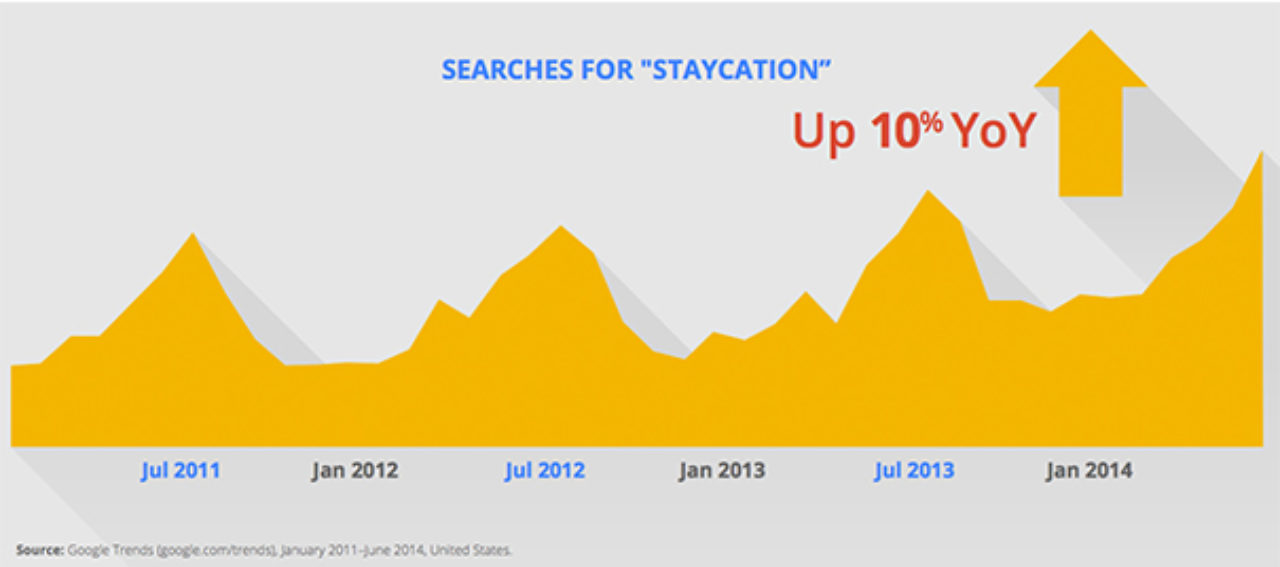Staycations: Backyard Getaways on the Rise

What’s trending in the travel industry? It’s less exotic than you might think. Today, many are opting to vacation at hotels just around the corner, and a look at industry data shows that the “staycation” is getting more popular by the year.
If you’re unfamiliar with the term, a staycation is a vacation taken at home or within comfortable driving distance. This could mean anything from a long weekend at the house to seven nights at a local hotel. Wherever people stay, though, one thing is abundantly clear: Many vacationers are ditching the overhead bins and leg cramps to relax close to home—and all for pennies on the dollar.
According to American Express, the average vacation expense per person in the United States is $1,145, or $4,580 for a family of four. That’s roughly 10% of the average American household’s yearly income, according to Census Bureau data.
Ouch.
Sure, folks are still taking vacations in the traditional sense, but for the budget conscious, local adventures are fast becoming a way of life. To verify this, go no further than your friendly neighborhood search engine, Google.
Google data shows that, since 2010, “staycation” has enjoyed a 58% rise in search frequency—with a 10% YOY increase in 2015 alone—and is forecasted to keep climbing with consistent peaks in July.

Just as important, a recent study found that real-world action is correlated with digital search trends—which researchers dub the “future orientation index.” Essentially, this means that search data reliably predicts behavior.
So get ready for the travelers next door, because what they search for today is what they’re going to do tomorrow. This means hotels that position themselves as prime staycation destinations will gain an increasing advantage in the coming years.
Even better, because they’re low-cost and less of a hassle, staycations are also enjoyed more frequently than traditional, two-week vacations. Rather than one large trip during the summer, the same amount of time “away” can be enjoyed as periodic mini-vacations sprinkled throughout the year. In fact, a prominent demographic that’s leading the market in quick trips is the millennial generation, or those age 18 to 34.
On average, millennials take 3.1 staycations per year in addition to a more traditional vacation. And more than any other generation, 55% are also taking overnight trips instead of traveling outside of their region. This stat is up nearly 30% since 2013.
Another recent survey revealed that 34% of millennials plan to take more staycations this year. All told, the top three reasons they decided to staycation were:
- To enjoy a hassle-free vacation experience (37%),
- To spend more quality time with loved ones (34%),
- And, to save money (30%).
With millennial families planning to spend an average of more than $6,000 total on vacations this year—or 19% more than last year—this demographic is a great example of what the hospitality industry can expect into the indefinite future.
Given the surging trend to staycation and its projection to increase in popularity, here are three things your property can do today to attract staycationers tomorrow:
1. Think local.
Expand into the local market. What events circulate through your community’s calendar every year? Are there music festivals, fairs, or pop-culture conferences that turn your town into a regional hub? These are all things to capitalize on through your marketing channels. Take advantage of their popularity in local media. By supporting or highlighting community events, you can attract folks to your destination by letting them know that all the action is right around the corner.
2. Think long-term.
Remember, staycationers take several "mini-trips” each year. This frequency can help create a more loyal customer base—a league of returning visitors motivated to spend their money close to home. And of course, increased patron loyalty equals greater revenue and profit. In fact, this could be a great opportunity for a local perks program to establish ongoing relationships with staycationers.
3. Think branding.
A brand is what consumers can expect from you. If your property is a luxury brand, that’s the experience people expect you to deliver. Or, if you are a business brand, folks expect conventions and conference rooms. No matter what your brand, though, it’s important to remember that it’s not static. It can and should evolve. And through the myriad of marketing and promotional channels at your disposal, your brand can grow to position itself to include a sense of community engagement and be positioned as a prime destination for a backyard getaway. Your property’s brand should help you remain top-of-mind for the experiences you can deliver. So leverage your marketing channels and position your property as the best vacation within driving distance.
The local vacation is here to stay. And if you think local, long-term, and develop your brand as an inviting staycation venue, you’ll be well on your way to capitalizing on this movement.

